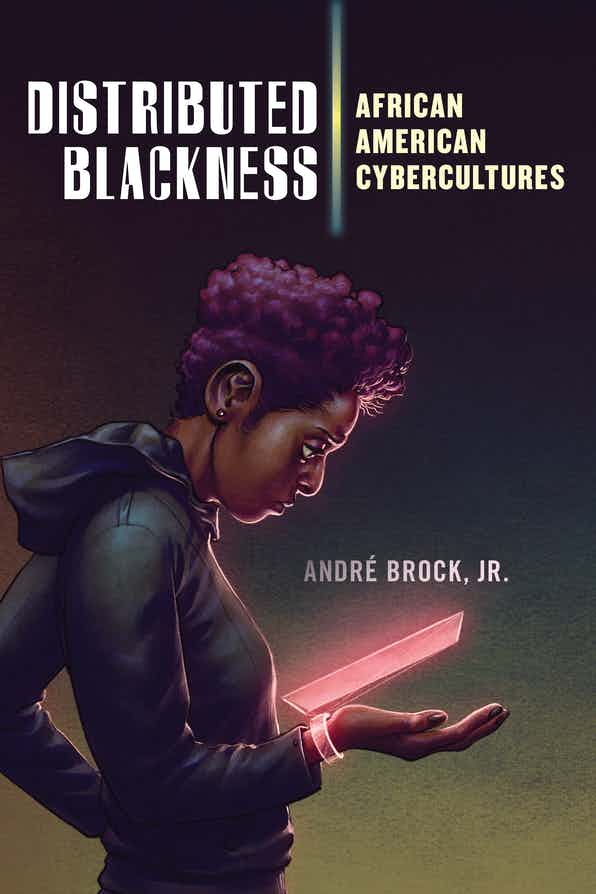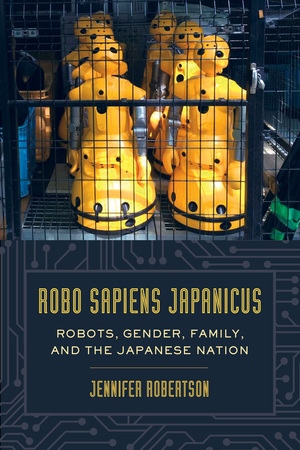What could we discover about the forces shaping the internet, and what could we learn about how to fight back against those forces if we committed to the metaphor of gentrification? In The Gentrification of the Internet: How to Reclaim Our Digital Freedom, Jessa Lingel shows that gentrification can be a useful lens through which to expose how power and class play out in online space. In a moment of increasing techno-skepticism, The Gentrification of the Internet offers a starting point for action, grounded in the reality of urban gentrification activism with proven results.
Keyword: technology
Review of Distributed Blackness: African American Cybercultures by André Brock, Jr. (New York University Press)
In Distributed Blackness: African American Cybercultures, interdisciplinary scholar André Brock, Jr. offers a timely and powerful examination of Blackness in the digital age. The book centers Black technology use from Black perspectives and investigates the online distribution of Black discourses. In six exploratory chapters, Brock reconceptualizes Black technoculture in a way that corrects deficit models of Black digital practice.
Review of Robo Sapiens Japanicus: Robots, Gender, Family, and the Japanese Nation by Jennifer Robertson (University of California Press)
Jennifer Robertson’s Robo Sapiens Japanicus: Robots, Gender, Family, and the Japanese Nation assesses the robot phenomenon in Japan within the last decade. Offering sustained critiques on contemporary techno-fix narratives, Robertson reveals how humanoid robots are designed and deployed to reify conservative values under the guise of technological advancements. Robertson’s impressive ethnographic project weaves together robots of science fact and fiction, leaving readers to interrogate how humanoids, androids, gynoids, and cyborgs both challenge and reify existing social structures across the globe.
Review of Open World Empire: Race, Erotics, and the Global Rise of Video Games by Christopher B. Patterson (New York University Press)
In Open World Empire: Race, Erotics, and the Global Rise of Video Games, Christopher B. Patterson critically analyzes video games through the methodological framework of erotics. In doing so, he provides astute insights into the ways in which video games can work to challenge essentialized narratives and constructions of race while also fostering greater awareness and understanding of one’s own place within the larger geopolitical systems of capitalism and empire. Through understanding video gamers as not simply passive receptors of ideology, but rather as active participants in the gameplay experience, he contends that video games create pleasure and other forms of affective engagement through erotic play. Through this erotic play, Patterson argues that “games enact playful protests against the power, identity, and order of information technology” (7).
Review of Digitize and Punish: Racial Criminalization in the Digital Age by Brian Jefferson (University of Minnesota Press)
In Digitize and Punish, Brian Jefferson argues that the US policing and incarceration infrastructure is increasingly marked by new forms of racialized digital criminalization. Examining the incorporation of digital technologies into the criminal justice apparatus, Jefferson shows the central role that digital technology and data science has had in reinforcing racial surveillance practices since the War on Drugs and Crime began more than four decades ago. Jefferson’s timely new book traces the merging of carcerality and technology in Chicago and New York City, unveiling forms of digital racial management that have remained largely obscured from the public.
Review of Gods and Robots: Myths, Machines, and Ancient Dreams of Technology by Adrienne Mayor (Princeton University Press)
In God and Robots: Myths, Machines, and Ancient Dreams of Technology, Adrienne Mayor opens up ancient history to new interpretations by adopting a rather capacious definition of technology, one that many scholars of the ancient world—according to Mayor—may reject out of hand. Focusing on biotechne, or artificial life, Mayor accepts any figure from the texts and artifacts of the ancient world which was “made, not born” as a technological creation. Mayor argues that ancient cultural constructions of technology were less about the inner workings of a black box (e.g., a giant metal robot) than about the imagining of such things existing in the first place. In nine chapters, Mayor recasts various myths and figures of the ancient Greek world in this new light. Gods and Robots serves as an important step in revealing how the idea of technology has functioned in ways both mythic and material from the beginning of recorded history.
Producing Art in the Ruins of a Former Colonial Industrial Hub: Arts Practices in Bulawayo, Zimbabwe (2000–2017)
This paper, focusing on Bulawayo, the country’s second largest city and regarded as the country’s cultural capital city, seeks to critically interrogate the working conditions of creative artists and other content producers against the background of an imploding cultural landscape. The paper seeks to establish ways in which cultural workers in Bulawayo negotiate the “precarious conditions” under which they work as they are exposed to the informalization of their labour, wage squeezes, temporariness, uncertainty, and pernicious risks in their work (Standing 2011; 2014; Waite, 2008; Munck, 2011). Artists in Bulawayo, Zimbabwe’s second largest city and the country’s former industrial hub, face a harsh operating environment such that some have even quit their craft. Some of the artists interviewed have concluded that their (bare) lives are more important than the preoccupation of producing art as this has had a toll on their families. However, there still exists a handful of artists who continue to struggle against all odds with the hope of building a sustainable arts industry in the country’s second largest city.
Review of Farm Worker Futurism: Speculative Technologies of Resistance by Curtis Marez (University of Minnesota Press)
In this focused visual-cultural history of farm work in California over the course of the twentieth century, Curtis Marez draws on a materialist and critical approach to understand the representations, in various media and formats, of farm workers, and of the activist movements that they have championed. Marez frames analyses of cultural artifacts, including speculative and science-fiction books and films, documentaries, propaganda, and studio artworks, in the historical and material conditions of those farm workers’ movements. Throughout, he foregrounds the people who shaped modern labor movements, from the vineyards of the San Fernando and San Joaquin Valleys and beyond. Marez argues that competing material interests, socio-technical mediations, and historical conditions—the animating conflicts of this account, between agribusiness and farm laborers—have shaped broader expressions of “americanism”, imagined futures, and visual cultures across North American societies, through the very contradictions that animate and constitute them.
Review of Archaeologies of Touch: Interfacing with Haptics from Electricity to Computing by David Parisi (University of Minnesota)
Archaeologies of Touch announces itself as an opening salvo for a new media studies subfield capable of addressing this ongoing haptic reconstruction of our media environment. Parisi charts a genealogy of haptic interfacing that begins with seventeenth-century experiments using electrostatic generators and culminates in the latest projections for virtual reality. Over several centuries, we have become rendered “haptic subjects” through an “ongoing cultural training” (43) though “tactile media”—a “shifting assemblage composed of technical elements, embodied sensations, and cultural practices” (97). No longer aiming to stimulate the full surface of the flesh, what now counts as touch-based media assures but one or a few points of contact between the tip of the finger and the screen. Far from fulfilling the fate of electronics by rebalancing the human sensorium, haptic feedback as we know it today seems a step in the opposite direction. Parisi closes his book with a spirited call to action insisting on the need for an interdisciplinary subfield of haptic media studies, on par with visual cultural studies and sound studies.
Queer Provisionality: Mapping the Generative Failures of the Transborder Immigrant Tool
Alison Reed investigates the border- and boundary-crossing performance of Electronic Disturbance Theater 2.0’sTransBorder Immigrant Tool (TBT), an incomplete cell phone program that offers GPS, guidance, and poetry to those attempting to cross into the United States across the Mexico/US border. Reed suggests a provocation-based performance of “queer provisionality,” revealing the aesthetics of oppressive power structures by juxtaposing them to social utopias. Interrogating the national neoliberal project of both US liberalism and US conservatism, Reed’s essay is also a transcription of the performances launched around TBT, the social and political machinery set into motion by Electronic Disturbance Theater’s failed utopian project.
Circuits to the Past
This series of photographs tracks digital signals across nine nodes of our fiber-optic undersea cable network – a system responsible for carrying 99% of all transoceanic internet traffic. The images document cable landings in the United States, Australia, New Zealand, and Tahiti, sites where submarine systems come aground and become entangled in the existing movements of both humans and nonhumans. Rather than locating us in an urban landscape, “Signal Tracks” hones in on the cable system’s rural and aquatic environments, extending from breaking waves over Sydney’s beaches, to mountains where brush fires scour O‘ahu’s west shore, to the habitats of endangered mountain beavers in northern California. Although on the surface these images appear absent of industrial infrastructure, the accompanying textual annotations highlight how such “natural” ecologies have been folded into contemporary digital systems.
E-Waste
My artwork investigates the materiality of digital culture, and the ways that our contemporary lavish lives are so dependent on the overlooked labor of lowbrow machines. E-Waste is a new sculptural investigation that incorporates a broad spectrum of USB-powered devices. The objects are partially encrusted with both “natural” and “man-made” environmental materials, yet these half-fossilized mutants continue to function, providing sources of light, sound, and movement.
Topographies of Interference
‘Topographies of Interference’ is meant to provoke viewers into thinking about information services’ material presence in the world, and to relocate the vision of large tech companies as primarily urban centers to one that highlights their presence in more rural communities, which often receives less attention.
In Search of Digital Feminisms: Digital Gender & Aesthetic Technology
What is it that influences girls’ choices of new technology? How is digital creativity affected by gender norms? “Digital Gender & Aesthetic Technology” aims to make visible females as creative developers of the Internet and new technology, through interviews with students, artists, project managers, and entrepreneurs. The prevailing social norms appear to be reflected on the Internet as “digital gender norms,” where girls and boys prefer apparently different communication tools. While working with the question of “digital gender,” I have developed the hypothesis of “Aesthetic Technology,” namely that girls often have an artistic approach towards technology. Girls mainly learn technology for a personal reason, planning to create something once they have learned the technique, and their goal often have aesthetic preferences. The question of girls “becoming technical,” is more complicated than one might first think, in relation to gender. Even though young girls are often just as interested in technology as young boys are, it is difficult for them to keep or adapt their technical interest to normative femininity in their teens. Another problem is that expressions of technical competence or innovation, which do not correspond to the predominant male norm, might be hard to recognize. Females who study within the field of creative digital technology often begin their career by struggling with questions of equality, instead of just practicing their profession.
BOT I
“BOT I” is a radical monologic mash-up of autobiographical material from Pilar’s childhood in a computing family and her passions for and against technology, cut in and through the texts of Samuel Beckett’s “Not I” and Isaac Asimov’s I Robot. This article includes the script of the performance Pilar presented at the Radical Philosophy Association Conference in Eugene, Oregon on November 13, 2010 and images from a 2011 performance. Ruthless in its refusal of all gentility and tact, and insistent in its feminist critique, Pilar’s script reveals the blind spots that capitalist techno-culture reserves for ethics and the body.









